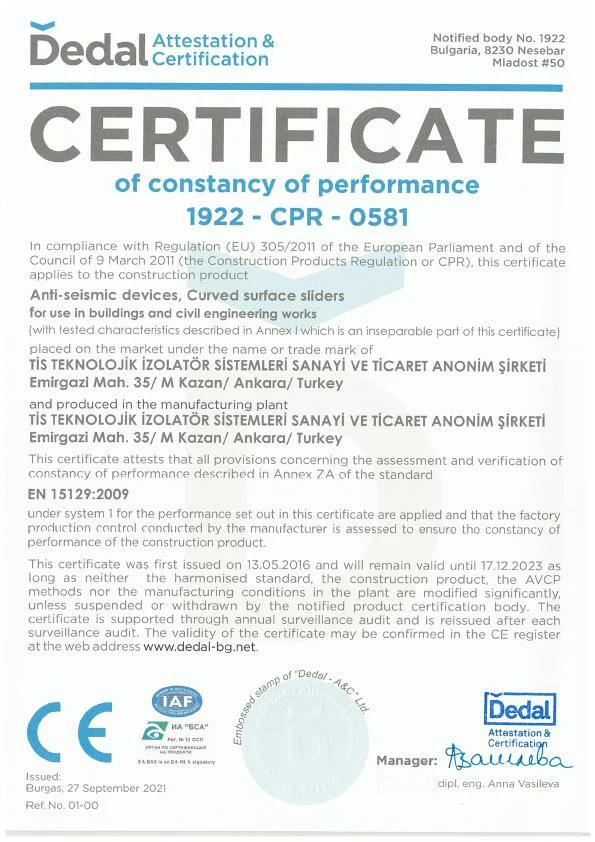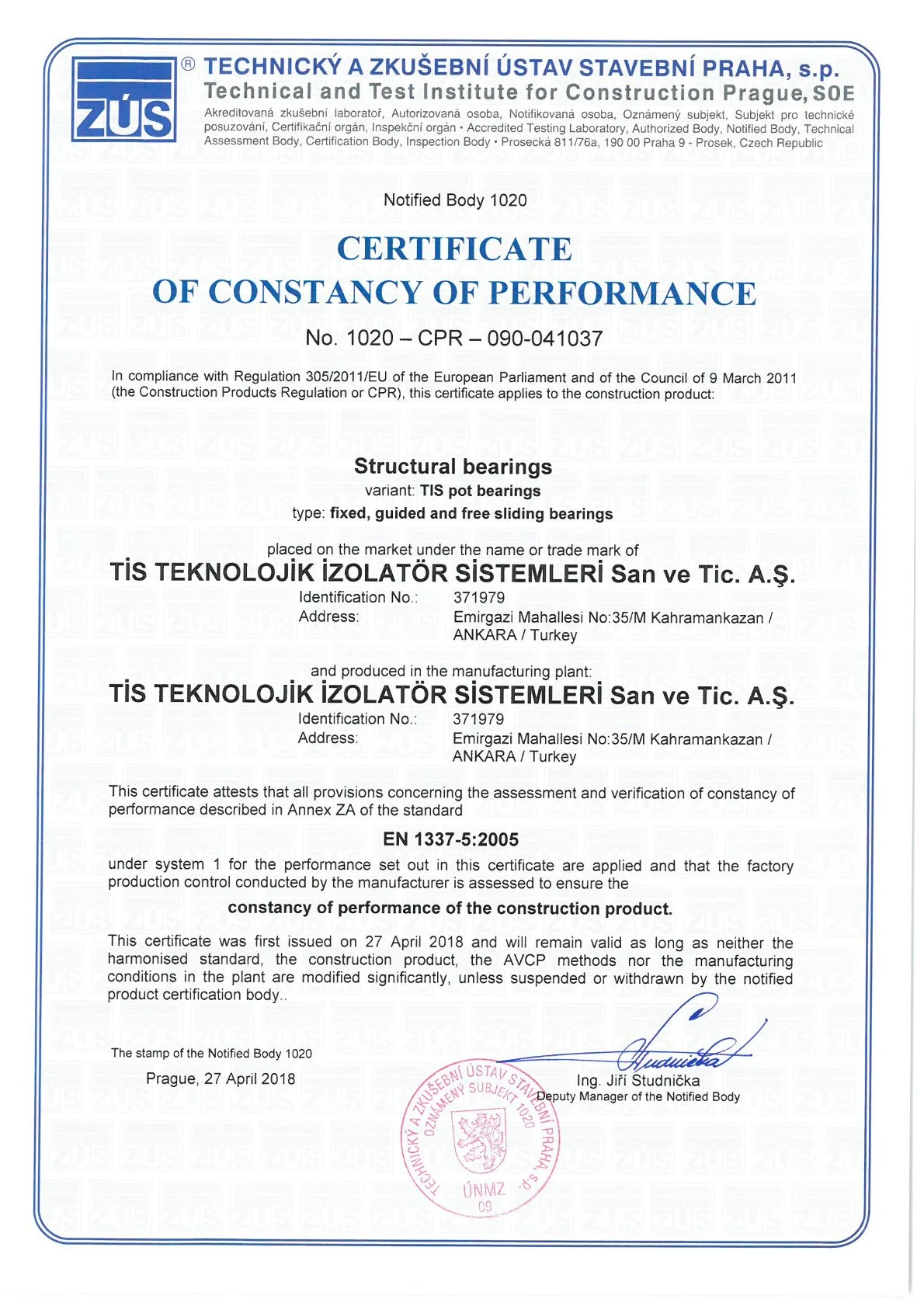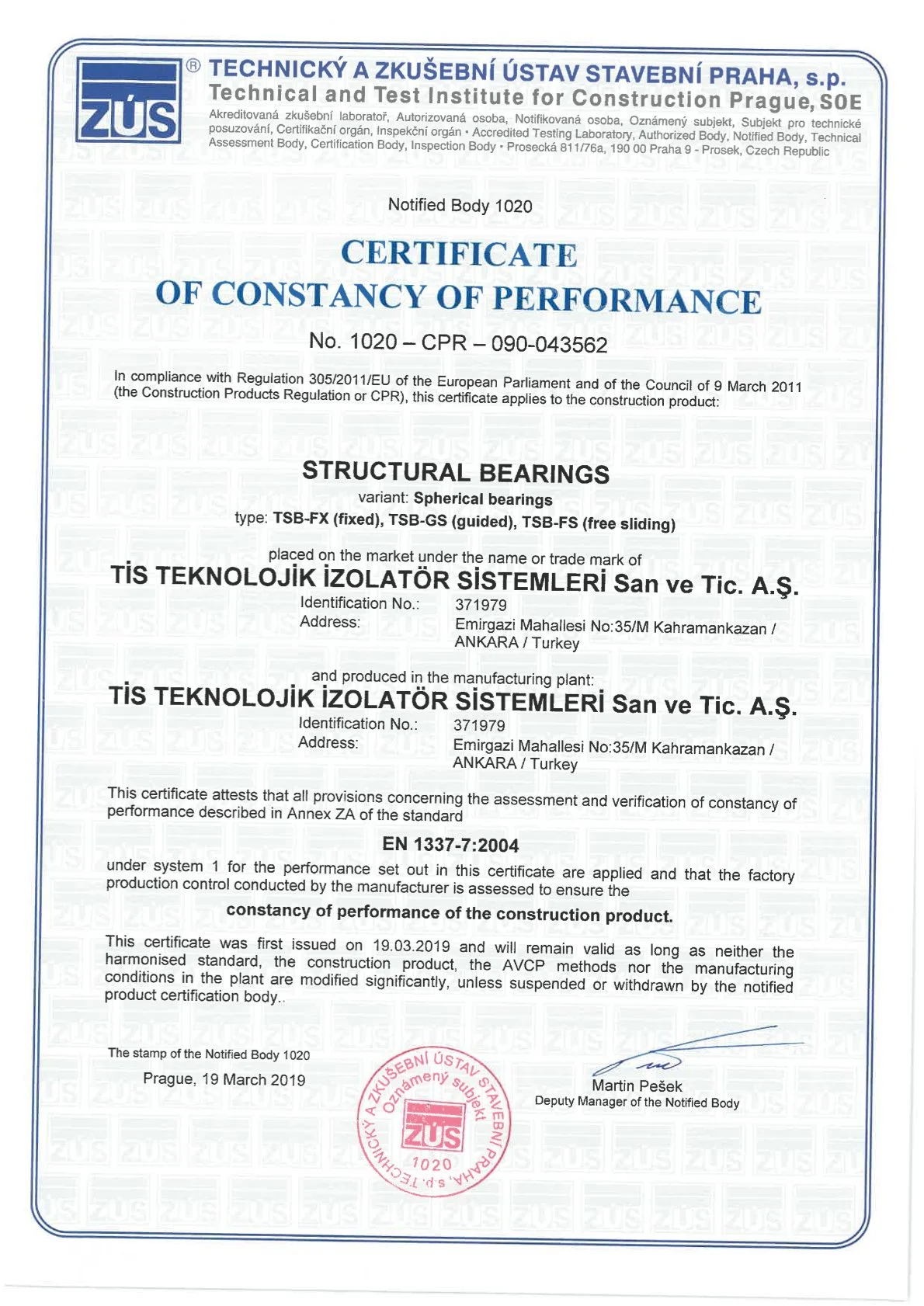Products
defenitions & catalogues
Certificates
TDP is a double spherical surface friction pendulum type earthquake isolator device developed by TİS. TDP consists of two sliding elements located between the support plate with the same radius of curvature. The lower and upper surfaces of the sliding element have the same properties and the radius of curvature is compatible with the support plates. In this way, the parallelism of the parts above and below the isolator plane of the building is maintained during the earthquake action.
In TDP, movement takes place simultaneously on both surfaces where the sliding element and support plates come into contact with each other. During an earthquake, two different materials on these surfaces move on each other to meet the need for horizontal displacement and energy absorption is achieved through the resulting friction. The materials on the friction surfaces are bright stainless steel sheet on the backing plate side, and Technoslide®, a patented special friction material developed by TİS on the sliding element side.
TIS Catalogue - TDP(click here)
Definition
TİS Pot Bearing (TPB) device is the pot bearing type used in structures to connect the different building elements (superstructure and substructure) produced by TİS Technological Isolator Systems A.Ş. The working principle of TPB bearings is basically to transmit the forces generated in the superstructure to the substructure at the desired rate and to allow the rotations created by the effects of the superstructure and other movement demands that the basic effects listed below will create.
- Loads
- Shrinkage and expansion in concrete
- Seismic effects
- Temperature changes
TPB bearings are designed in accordance with the conditions specified in all relevant parts of TS EN 1337, especially TS EN 1337-2 and TS EN 1337-5.
Types
TPB bearings are produced in 3 different types according to these force and displacement interactions that need to be regulated. Bowl bearings produced by TIS A.Ş. are listed below.
- Fixed bearing: TPB-FX
- Free sliding pot bearing: TPB-FS
- Guided sliding pot bearing: TPB-GS
TPB-FX TBP-FX
TPB-FX TBP-FX consists of a rubber pad inside a pot-shaped steel element and a steel piston that presses on the rubber pad and provides rotational motion. This type of bearings counteract horizontal displacement demands in all directions and allow the superstructure to rotate only around any horizontal axis. Since the rubber pad in the pot is restricted from all sides, it acts as an incompressible fluid under very high vertical loads and creates high resistance against the pressure created by this vertical load and allows the piston to rotate with the shear deformation in the rubber. In addition, it transmits the horizontal forces existing in the superstructure and transferred to the piston connected to it, to the pot and thus to the substructure through the piston-pot wall contact.

TPB-FS
TPB-FS is created by placing a plate on a TPB-FX type support that can slide in any direction in the horizontal direction. This surface consists of a dimpled PTFE plate fixed on the piston and a sliding plate on this PTFE plate, on which is placed polished stainless steel on its bottom surface. This sliding surface allows the upper structure to move in all horizontal directions relative to the substructure, with the low friction contributed by the oil contained in the pits of the PTFE plate. In addition, it does not transfer the horizontal forces existing in the superstructure to the infrastructure.

TPB-GS
TPB-GS is almost the same as a TPB-FS type bearing, but this type of bearing has a guide placed in one direction in the middle of the PTFE-inserted piston top surface. In addition, there is a recess in the sliding top plate where the guide will be placed. The guide ensures that the upper plate moves only in the direction of design displacement and prevents the movement in all other directions and transmits the horizontal force generated in those directions to the lower parts and the substructure through the upper plate-guide contact.

Bearing Elements
- 1. Pot
- 2.Rubber cushion and inner gasket
- 3. Piston
- 4. PTFE
- 5. Slide
- 6.CM1 Composite material
- 7.Top plate
- 8.Stainless steel
- 9. Anchor bolts
- 10. Protection system against dust

Material Properties
Cup, piston, guide and top plates of TPB bearing are produced from S355 structural steel. Since S355 steel is a material whose properties are well known, it provides convenience in both design and processing processes. In addition, S355 structural steel has proven its strength with its performance under various structural loads.
The rubber cushion inside the pot, with a compressive strength of 60 MPa and a minimum Shore A50 hardness, ensures that the vertical force is transmitted to the substructure without damaging the bearing, and provides resistance to rotational movements without damage during its use.
High quality POM or carbon filled PTFE gasket is used to prevent the pad from coming out of the pot during the rotational movements of the piston on the rubber pad or to prevent it from being damaged during the compression-opening movement.
In guided or free sliding bearings, grooved PTFE and lubricant oil with a pressure resistance of at least 90 MPa are used, these materials provide both high vertical pressure resistance and a low friction coefficient sliding surface.
In guided sliding bearings, composite materials with a compressive strength of at least 200 MPa and a low friction coefficient are used to provide a sliding surface on the side surfaces of the guide and to withstand horizontal loads transferred from the top plate to the guide
TPB Catalogue (click here)
TSP is a single spherical surface friction pendulum type earthquake isolator device developed by TİS. TSP consists of two sliding elements located between the support plate with different radius of curvature. The upper and lower surfaces of the sliding member have the radii of curvature of the support plates with which they are matched.
In TSP, one surface of the sliding element is located on the steel support plate and meets the horizontal displacement demand. This surface also determines the oscillation period. The other surface is placed on the other support plate in a way that prevents horizontal movement and only provides rotation. During horizontal movement, the parallelism between the substructure and superstructure can also be maintained in this way.



